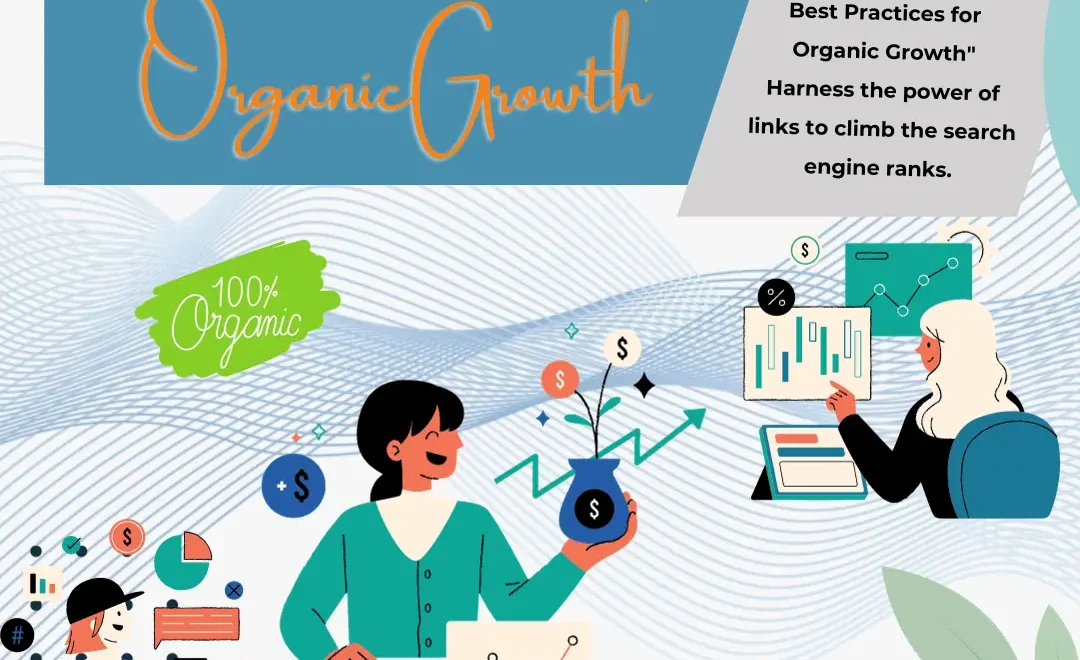In the ever-evolving realm of SEO, hyperlink building remains a vital and fundamental strategy for boosting your website’s visibility and climbing the search engine ranks. The significance of hyperlink building lies in its capacity to establish your website’s authority and relevance in the eyes of search engines like Google, especially Google.
With search algorithms becoming increasingly sophisticated, it’s imperative to adopt the best practices for organic growth in 2023. These algorithms are designed to discern not only the quantity but also the quality of links pointing to your website. In this highly competitive digital landscape, merely accumulating a large number of backlinks is no longer sufficient. Search engines are now more discerning, favoring quality and relevance over quantity.
This comprehensive guide will delve into the handiest and most up-to-date processes to harnessing the electricity of hyperlinks, supplying you with precious insights to outrank the competition on Google. It will equip you with the know-how and techniques needed to thrive in search engine optimization surroundings wherein outstanding, authoritative backlinks are the foreign money of online success
Understanding the Importance of Link Building
1.1 Link Quality vs. Quantity
In 2023, the quality of the links pointing to your website holds more weight than the sheer number of links. Google’s algorithms have evolved to distinguish between valuable and spammy links. Here’s why link quality matters:
Example: Imagine you run a tech blog, and you have two potential backlinks:
A single link from a renowned technology news website like TechCrunch, which is considered an authoritative source in your niche.
Twenty links from random, low-quality blogs or websites with no connection to the tech industry.
In this scenario, the single link from TechCrunch is more valuable than the twenty from unrelated, low-quality sources. Google recognizes the trustworthiness of TechCrunch and assigns higher importance to the link, ultimately boosting your website’s credibility and search engine ranking.
1.2 The Relevance Factor
The relevance of the website’s linking to your content plays a pivotal role in the success of your link building strategy. In simple terms, this means that the websites linking to you should clearly connect to your industry or topic.
Example: Let’s say you operate a website selling gardening tools. You secure two backlinks:
A link from a gardening forum where users discuss the latest tools and techniques.
A link from a website specializing in car reviews, with no connection to gardening.
The first link, originating from the gardening forum, is relevant because it’s in the same niche as your website. Users on that forum are interested in gardening, making it more likely that they’ll click on your link, visit your website, and potentially make a purchase. This targeted traffic not only benefits your SEO but can also lead to more sales, creating a “win-win” situation.
On the other hand, the link from the car review website, which is unrelated, is less likely to attract the right audience. It might not drive the same level of targeted traffic or have the same positive impact on your SEO efforts.
By focusing on the quality and relevance of your backlinks, you’ll effectively harness the power of link-building to improve your search engine rankings and reach a more engaged audience in 2023.
Crafting an Effective Link-Building Strategy
2.1 Guest Blogging
Guest blogging remains a powerful link-building strategy in 2023. It involves collaborating with authoritative websites in your industry and providing well-crafted guest posts. These guest posts offer substantial value to the target audience while also securing authoritative backlinks to your website.
Example: Suppose you run a technology blog. You can method main tech websites or blogs and advice to jot down a visitor publish on a trending tech topic. Your visitor publication ought to be in-depth, properly researched, and offer particular insights. By doing so, you not simplest offer precious statistics to their readers but also benefit from an exquisite one-way link from an industry chief.
2.2 Broken Link Building
Broken hyperlink building is a link-constructing method that includes figuring out damaged or non-functional hyperlinks on reputable websites inside your area of interest. You then reach out to the website proprietors and suggest changing the broken hyperlinks with hyperlink building on your applicable, awesome content material. This strategy now not only blessings your website’s search engine optimization but also aids internet site proprietors in retaining the integrity of their content material.
Example: Let’s say you have an internet site focusing on fitness and nutrition. You find a well-known fitness weblog with a broken link in every one of its articles.
The broken link points to a resource about healthy meal planning. You can contact the blog owner and offer to provide them with an updated, high-quality guide on meal planning. By doing this, you not only help them fix their broken link but also gain a valuable backlink to your meal planning guide.
2.3 Skyscraper Technique
The Skyscraper Technique is a highly effective link-building method that involves finding popular content within your niche and creating even more valuable, comprehensive, and up-to-date content on the same topic. Afterward, you reach out to websites that previously linked to the original content, informing them of your superior resource. This approach often results in them linking to your content instead.
Example: Imagine you run a blog about digital marketing. You find a well-received article about “Top Social Media Marketing Strategies for 2023.” To employ the Skyscraper Technique, you’d create an even more comprehensive guide on the same topic, including the latest strategies and case studies. Then, you contact the websites that linked to the original article, letting them know about your superior guide. Because your content offers more value and up-to-date information, they are more likely to replace their links with links to your guide.
Building a Strong Internal Link Structure
3.1 Interlinking: Enhancing User Experience and SEO
Internal linking performs an essential role in enhancing your website’s structure, each for the gain of users and search engines. When correctly implemented, it guarantees that each page on your website online is strategically linked to other applicable pages, developing a web of connections that fosters a smoother navigation experience and strengthens your search engine optimization efforts.
Example: Suppose you run a weblog approximately health and have an editorial discussing “The Benefits of Cardio Workouts.”
Within this article, you mention the importance of a balanced diet. To enhance user experience and SEO, you can add an internal link to another page on your site that specifically talks about “Balanced Diet Tips for Fitness Enthusiasts.” By doing this, you’re helping users easily access related content and keeping them engaged on your site. Search engines, in turn, recognize this as a positive user experience signal, which can improve your search rankings.
3.2 Anchor Text Optimization: Making Links Understandable
Optimizing anchor text is a simple but powerful technique for making your internal links more understandable and beneficial for both users and search engines. Anchor text is the seen, clickable text inside a hyperlink, and it serves as a cue to assist search engines like Google and Yahoo in recognizing the context and relevance of the connected pages.
Example: Let’s say you’re writing a brand new article about “Strength Training for Beginners” and want to create an inner hyperlink to an older post titled “Building Muscle Safely.” Instead of the usage of prevalent anchor text like “Click here” or “Read more,” you need to use descriptive and keyword-rich anchor text. In this example, you can use “Learn a way to build muscle correctly” as your anchor textual content. This presents customers with a clear idea of what they’ll locate when they click the link and enables search engines to perceive the topic of the related page.
The use of relevant keywords in anchor text can boost your search rankings for those specific terms.
By following these simple yet effective practices of interlinking and anchor text optimization, you not only improve the user experience on your website but also enhance your SEO efforts, ultimately helping your site outrank the competition in Google search results.

The Role of Social Signals
4.1 Social Sharing
In 2023, social signals, which include actions like likes, shares, and comments on social media platforms, continue to significantly influence your website’s search engine rankings. Let’s delve into this with clear and simple examples to understand how social sharing can boost your online presence.
The Power of Likes and Shares
Imagine you’ve simply published a high-quality article on your internet site, and it includes precious statistics or enticing content material. When traffic comes to your web page and finds your content material helpful, they may click on the “Like” button or use a “Share” option to unfold the phrase approximately on systems like Facebook, Twitter, or LinkedIn.
Likes: When a person likes your content on social media, it’s like a digital thumbs-up. It shows that human beings admire what you’ve shared, and this action sends positive signals to SERPS. It tells SERPS that your content is valuable and really worth promoting.
Shares: Sharing is even more potent. When a person shares your content material, they may be essentially recommending it to their very own network of pals, fans, or connections. This no longer simply drives extra visitors to your website but also tells SERPS that your content material is authoritative and truthful.
The Role of Comments: Additionally, social signals also encompass comments on your content. Imagine you have a blog post, and readers leave insightful comments, asking questions or sharing their thoughts. These comments create engagement and interaction around your content.
Engagement: When users comment on your content, it indicates that people are actively engaging with what you’ve shared. Search engines view this as a sign of the quality and relevance of your content.
Conversations: Comments can also spark meaningful conversations related to your content, which adds depth and context to your topic. This enhances the overall user experience and contributes to a positive signal for search engines.
Encouraging Social Sharing
To harness the power of social signals, you can take proactive steps:
Social Share Buttons: Make it easy for your internet site visitors to percentage your content material. Include social percentage buttons prominently on your web pages. These buttons allow users to quickly proportion your content with their social networks.
Engagement with Your Audience: Interact with your target audience on social media. Respond to comments, and solution questions, and actively take part in conversations related to your content material. This not simplest strengthens your online community but also encourages greater social engagement.
Quality Content: The basis of powerful social sharing is terrific content. Create content that is informative, engaging, and applicable to your target market. When human beings discover your content material is treasured, they may be much more likely to proportion it.
Monitoring and Adaptation
5.1 Regular Analysis
Continuous monitoring and analysis are crucial for your link-building strategy. Here’s how you can effectively track your progress and make informed adjustments:
5.1.1 Utilize SEO Tools
Employ user-friendly SEO tools like Moz, Ahrefs, or SEMrush to keep a close eye on your backlinks. These tools provide user-friendly dashboards that display essential data about your website’s link profile.
5.1.2 Assess Link Quality
When monitoring your backlinks, focus on their quality rather than quantity. Look for high-authority websites that link to your content. For instance, if you have a blog post about “Healthy Eating Tips,” a backlink from a respected health and fitness website is more valuable than several links from unrelated or low-quality sites.
5.1.3 Track Rankings
Regularly check the search engine rankings of your targeted keywords. SEO tools often include features that allow you to monitor your keyword positions over time. If you notice a drop in rankings, investigate whether any of your backlinks have been removed or if there are new competitors in the field.
5.1.4 Keep an Eye on Your Competitors
Competitor analysis is essential. Identify who your top competitors are and monitor their link-building strategies. By understanding what works for them, you can adapt your own strategy to stay ahead in the game.
5.1.5 Monitor Traffic and Conversions
In addition to keyword rankings, observe the traffic and conversions that result from your link-building efforts. Tools like Google Analytics can help you track the visitors referred by your backlinks and how many of them convert into leads or customers.
5.1.6 Adjust and Optimize
Based on your findings, make necessary adjustments to your link-building strategy. If you identify low-quality backlinks, consider disavowing them through Google Search Console. If your rankings have improved thanks to specific backlinks, try to replicate those strategies for more success.
5.1.7 Stay Informed
SEO is ever-changing. Stay updated with the latest trends, algorithm updates, and industry news. Adapt your strategy accordingly to maintain your competitive edge and continue climbing the search engine ranks in 2023.
Regular analysis and adaptation are essential for the ongoing success of your link-building efforts, ensuring that you stay ahead of the competition and outrank other websites on Google.
Conclusion
In the dynamic landscape of SEO, staying updated with the latest link-building best practices is essential. In 2023, the focus is on quality over quantity, relevance, and the incorporation of social signals. Implement these strategies with the expertise of California Website Designer Agency, build a robust internal link structure, and continually analyze your progress to climb the search engine ranks and outperform your competitors.

Frequently Asked Questions
Q1: What is link building, and why is it important in 2023 for organic growth?
A1: Link building is the process of acquiring hyperlinks from other websites to your own. In 2023, it’s crucial for organic growth because search engines like Google use these links as a major factor to determine the authority and relevance of your website. Quality backlinks can significantly boost your search engine rankings.
Q2: Are all links equally valuable, or should I focus on specific types of links?
A2: Not all links are equal. Quality matters more than quantity. High-quality, relevant, and authoritative links from trusted websites in your niche are far more valuable than numerous low-quality links. Focus on acquiring the former.
Q3: How can I find reputable websites to get backlinks from?
A3: You can find reputable websites for backlinks by conducting research within your industry, identifying authoritative sources, and reaching out to them for collaboration or guest posting. Use tools like Ahrefs or SEMrush to find potential link-building opportunities.
Q4: Is guest blogging still an effective link-building strategy in 2023?
A4: Yes, guest blogging remains a powerful strategy. By developing brilliant guest posts for authoritative websites for your niche, you could stable treasured one-way links and boost your internet site’s visibility.
Q5: What is the Skyscraper Technique, and in the way is it painting?
A5: The Skyscraper Technique includes locating famous content in your niche, growing even better and greater comprehensive content material, after which reaching out to websites that link to the unique content, asking them to link in your superior resource. This approach can earn you remarkable back-links.
Q6: Do internal link-building matter for SEO, and how should I use them effectively?
A6: Internal links are essential for SEO. They help users navigate your website and assist search engines in understanding your content’s structure. Use relevant anchor text and interlink your content strategically to enhance both user experience and SEO.
Q7: How can I measure the impact of my link building efforts?
A7: You can degree the impact of your link-constructing efforts by using the use of search engine optimization gear to track one-way links, display keyword rankings, and examine internet site traffic and conversion information. These metrics will assist you in gauging the achievement of your strategy.
Q8: What are social signals, and why do they depend on link building?
A8: Social signals refer to the activity and engagement your content receives on social media platforms. In 2023, social signals continue to impact search engine rankings. When your content is shared and discussed on social media, it sends positive signals to search engines, potentially improving your SEO.
Q9: How often should I update my link building strategy to stay competitive?
A9: Regular updates to your link-building strategy are essential. Keep an eye on industry trends, algorithm updates, and competitor activities. Adapt your approach as needed to stay ahead in the ever-evolving field of SEO.
Q10: Are there any risks involved in link building, and how can I mitigate them?
A10: Yes, there are risks such as acquiring low-quality or spammy links that can harm your SEO. To mitigate these risks, regularly analyze your backlink profile, disavow toxic links, and focus on quality over quantity in your link-building efforts. Staying informed and using reputable sources for link-building can also minimize risks.






